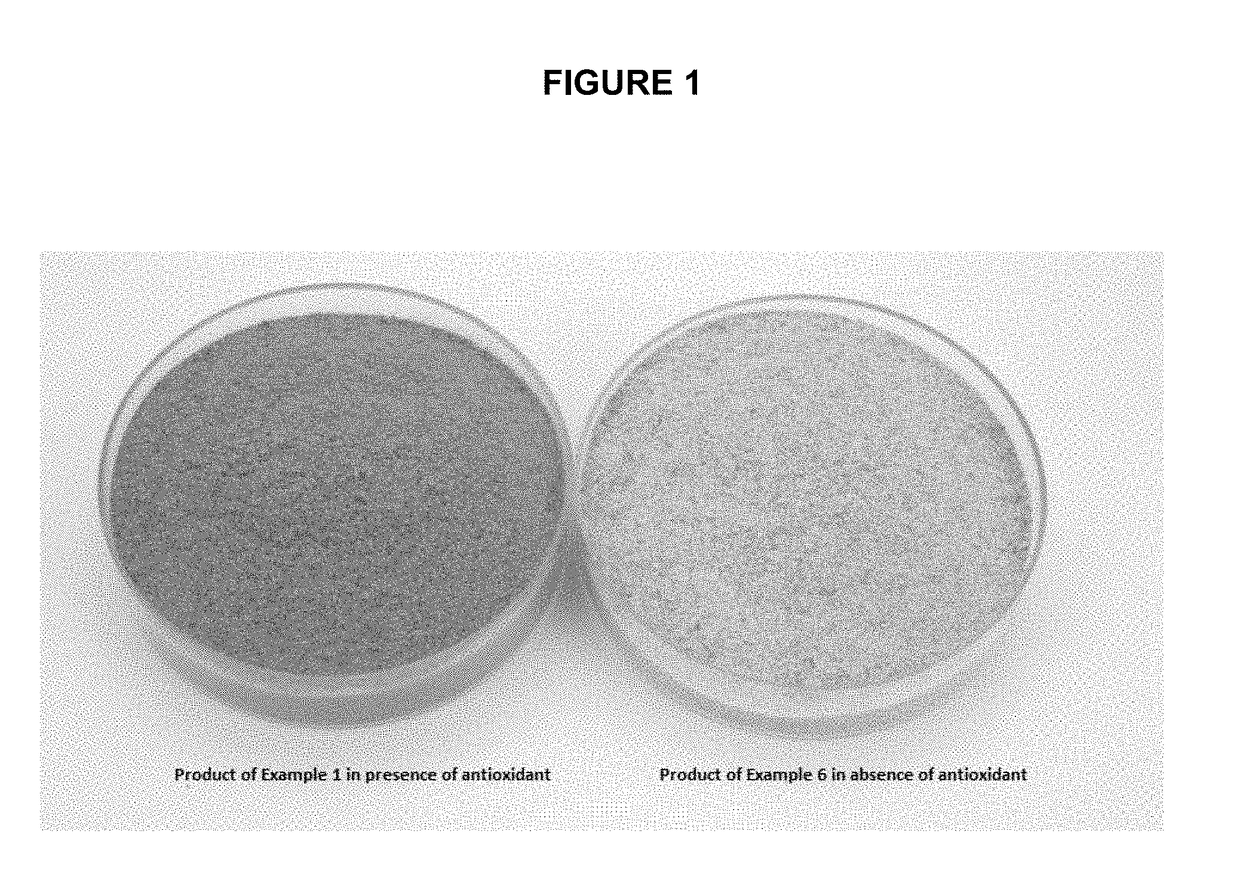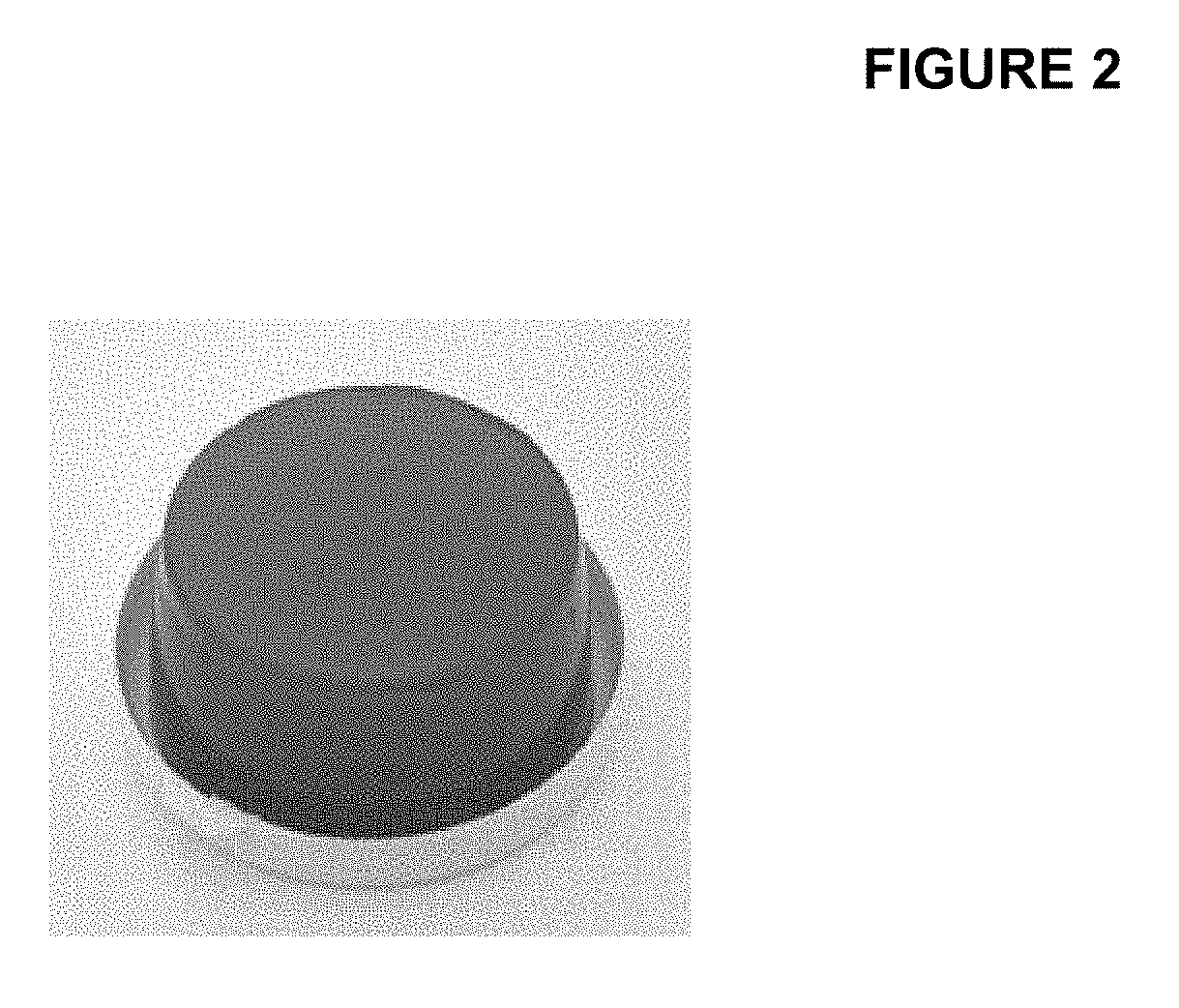Plant-derived colouring texturants
a texturizing agent and plant-derived technology, applied in the field of plant-derived texturizing agents, can solve the problems of not being suitable for use, or intended for preparation, and achieve the effect of preventing oxidative degradation and preventing the degradation of a substantial portion of carotenoid
- Summary
- Abstract
- Description
- Claims
- Application Information
AI Technical Summary
Benefits of technology
Problems solved by technology
Method used
Image
Examples
example 1
Preparation of a Texturizing and Colouring Agent from Orange Carrot
[0132]Carrots were chopped into discs and blanched in boiling water for 1 minute. The blanched carrot discs were then juiced and pulp was retained. The pulp was then cooled to 5° C., re-suspended in about 5 times weight of de-ionised water, and the pH was adjusted to and maintained at about pH12 using a slurry of 50% w / w Ca(OH)2 in de-ionised water. The resulting mixture was incubated for 1 hour at 5° C. The mixture was then filtered and the retained pulp was re-suspended in about 5 times weight of de-ionised water, and the pH was adjusted to and maintained about pH1.3 for 10 minutes at room temperature (about 22° C.) using 18% v / v HCl solution in water. The mixture was then filtered to retain the pulp. This acid wash cycle was repeated twice. The acidified retained pulp was then washed with de-ionised water until the pH was the range from 3.0 to 3.3. The mixture was then filtered to retain the pulp. 25% w / v of ascor...
example 2
Preparation of a Jam Composition that is Coloured and Texturised by use of a Dual Function Texturizing and Colouring Agent Prepared from Orange Carrot
[0133]The texturizing and colouring agent of Example 1 was used in the preparation of a jam in accordance with the following jam recipe (1000 grams batch size trial):
TABLE 2Ingredient% w / wSucrose40Glucose syrup 42DE28Texturizing and colouring agent of Example 1150% w / w citric acid solution0.48Water30.5Total100
[0134]Dry blend the texturizing and colouring agent of Example 1 with 3 times more sucrose.
[0135]Disperse the dry blend in water pre-heated to 100° C. and mix for 1 minute.
[0136]Pre-heated the glucose syrup to 90° C. and add into the mixture.
[0137]Add remaining sucrose into the mixture.
[0138]Heat the solution to 100° C. and mix until 67° Brix is achieved upon addition of 50% citric acid solution.
[0139]Hot fill the resulting mixture into containers, and rest the filled containers for natural cooling at room temperature (i.e. about ...
example 3
Effects of Final pH on a Jam Composition that is Coloured and Texturised by Use of a Dual Function Texturizing and Colouring Agent Prepared from Orange Carrot
[0142]The jam composition recipe provided in Example 1 was used to create jams having about 64 to 66 Brix and different pH levels by varying the amounts of the citric acid solution and water added to the composition during its preparation. The resulting jam products of varying pH levels were analysed for gel strength at room temperature (i.e. about 22° C.) using the methodology described on Example 2. Results are shown in Table 3.
TABLE 3GelstrengthSyner-pHBrix(g)esisTexture4.2864n / anoneshort texture, viscous liquid form3.5664203.8nonegelled texture, spoonable and spreadable3.465200.6nonegelled texture, spoonable and spreadable3.1865163.8nonegelled texture, spoonable and spreadable3.1266119.1nonegelled texture, spoonable and spreadable
PUM
 Login to View More
Login to View More Abstract
Description
Claims
Application Information
 Login to View More
Login to View More - R&D
- Intellectual Property
- Life Sciences
- Materials
- Tech Scout
- Unparalleled Data Quality
- Higher Quality Content
- 60% Fewer Hallucinations
Browse by: Latest US Patents, China's latest patents, Technical Efficacy Thesaurus, Application Domain, Technology Topic, Popular Technical Reports.
© 2025 PatSnap. All rights reserved.Legal|Privacy policy|Modern Slavery Act Transparency Statement|Sitemap|About US| Contact US: help@patsnap.com


